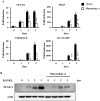Placotylene A, an inhibitor of the receptor activator of nuclear factor-κB ligand-induced osteoclast differentiation, from a Korean sponge Placospongia sp
- PMID: 24705502
- PMCID: PMC4012465
- DOI: 10.3390/md12042054
Placotylene A, an inhibitor of the receptor activator of nuclear factor-κB ligand-induced osteoclast differentiation, from a Korean sponge Placospongia sp
Abstract
A new inhibitor, placotylene A (1), of the receptor activator of nuclear factor-κB ligand (RANKL)-induced osteoclast differentiation, and a regioisomer of placotylene A, placotylene B (2), were isolated from a Korean marine sponge Placospongia sp. The chemical structures of placotylenes A and B were elucidated on the basis of 1D and 2D NMR, along with MS spectral analysis and revealed as an iodinated polyacetylene class of natural products. Placotylene A (1) displayed inhibitory activity against RANKL-induced osteoclast differentiation at 10 μM while placotylene B (2) did not show any significant activity up to 100 μM, respectively.
Figures





Similar articles
-
Suppression of RANKL-Induced Osteoclastogenesis by the Metabolites from the Marine Fungus Aspergillus flocculosus Isolated from a Sponge Stylissa sp.Mar Drugs. 2018 Jan 5;16(1):14. doi: 10.3390/md16010014. Mar Drugs. 2018. PMID: 29304006 Free PMC article.
-
The Natural Product 6-Gingerol Inhibits Inflammation-Associated Osteoclast Differentiation via Reduction of Prostaglandin E₂ Levels.Int J Mol Sci. 2018 Jul 16;19(7):2068. doi: 10.3390/ijms19072068. Int J Mol Sci. 2018. PMID: 30013004 Free PMC article.
-
Five Easy Pieces. The Total Synthesis of Phosphoiodyn A (and Placotylene A).Org Lett. 2015 Nov 20;17(22):5544-6. doi: 10.1021/acs.orglett.5b02642. Epub 2015 Oct 28. Org Lett. 2015. PMID: 26509219
-
Haliclonyne, a new highly oxygenated polyacetylene from the marine sponge Haliclona species.J Nat Prod. 2000 Apr;63(4):523-6. doi: 10.1021/np990342m. J Nat Prod. 2000. PMID: 10785431
-
Chlorogenic acid inhibits osteoclast differentiation and bone resorption by down-regulation of receptor activator of nuclear factor kappa-B ligand-induced nuclear factor of activated T cells c1 expression.Biol Pharm Bull. 2013;36(11):1779-86. doi: 10.1248/bpb.b13-00430. Epub 2013 Aug 28. Biol Pharm Bull. 2013. PMID: 23985829
Cited by
-
Effect of Usnic Acid on Osteoclastogenic Activity.J Clin Med. 2018 Oct 12;7(10):345. doi: 10.3390/jcm7100345. J Clin Med. 2018. PMID: 30322046 Free PMC article.
-
Naturally Occurring Organohalogen Compounds-A Comprehensive Review.Prog Chem Org Nat Prod. 2023;121:1-546. doi: 10.1007/978-3-031-26629-4_1. Prog Chem Org Nat Prod. 2023. PMID: 37488466 Review.
-
Chemical and biological diversity of new natural products from marine sponges: a review (2009-2018).Mar Life Sci Technol. 2022 Aug 1;4(3):356-372. doi: 10.1007/s42995-022-00132-3. eCollection 2022 Aug. Mar Life Sci Technol. 2022. PMID: 37073163 Free PMC article. Review.
-
Water Extracts of Hull-less Waxy Barley (Hordeum vulgare L.) Cultivar 'Boseokchal' Inhibit RANKL-induced Osteoclastogenesis.Molecules. 2019 Oct 16;24(20):3735. doi: 10.3390/molecules24203735. Molecules. 2019. PMID: 31623242 Free PMC article.
-
Saccharomonopyrones A-C, New α-Pyrones from a Marine Sediment-Derived Bacterium Saccharomonospora sp. CNQ-490.Mar Drugs. 2017 Aug 3;15(8):239. doi: 10.3390/md15080239. Mar Drugs. 2017. PMID: 28771166 Free PMC article.
References
-
- Gribble G.W. Natural organohalogens: A new frontier for medicinal agents? J. Chem. Educ. 2004;81:1441–1449. doi: 10.1021/ed081p1441. - DOI
-
- Faulkner D.J. Marine natural products. Nat. Prod. Rep. 1997;14:259–302.
-
- Lerch M.L., Harper M.K., Faulkner D.J. Brominated polyacetylenes from the Philippines sponge Diplastrella sp. J. Nat. Prod. 2003;66:667–670. - PubMed
-
- Bourguet-Kondracki M.L., Rakotoatisoa M.T., Martin M.T., Guyot M. Brominated polyacetylenic acids from the marine sponge Xestospongia muta: Inhibitors of HIV protease. Tetrahedron Lett. 1992;33:225–226.
Publication types
MeSH terms
Substances
LinkOut - more resources
Full Text Sources
Other Literature Sources

